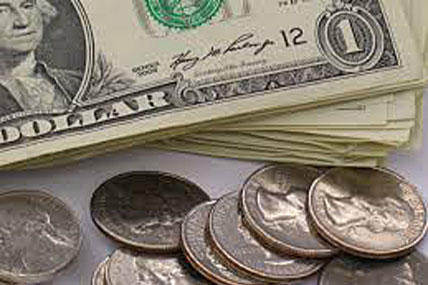Remember the dark days after the financial collapse in 2008? Many investors tossed quarterly investment account statements into unopened piles. Some did grim mental calculations of how much longer they would have to work to save for retirement.
These days, thanks to recent stock market gains, investors may be able to look at those 401(k), IRA and stock portfolio statements again without cringing. But for those who think markets are headed back to the sparkling gains of the go-go years of the 1980s and '90s, think again.
In truth, we are still clawing our way back from the depths of the Great Recession. And it's unlikely we will soon see anything like the 8% average annual returns specialists and fund managers assert that a diversified portfolio of stocks and bonds could earn historically. Pension funds, facing steep shortfalls, certainly faced this harsh reality the last few years.
Consider this: Yields on Treasury bonds have hit record lows, according to the Treasury Department, while yields on dividend-paying stocks also are mediocre by historical standards, based on data from the Standard & Poor's 500 index. What does this mean for your portfolio? Will your return be significantly lower than the 8% historical average?
The answer is yes, according to financial specialists we interviewed. And whether dire predictions about market performance turn out to be right or wrong, "It probably pushes individuals to understand that they need to save much more," says Gregory Rivas, executive director for retirement with USAA.
A Word About Those Yields
Some online retirement calculators may ask you to estimate the average annual returns on your portfolio, or they may assume a specific rate of future growth based on the historical returns of a portfolio similar to yours. In an investing environment with danger signs everywhere, however, this approach may be dangerously optimistic, our research analysts say.
"I think you have to open up the window and get a sense of the weather outside," says Moshe Milevsky, associate professor of finance at York University in Toronto and author of "Are You a Stock or a Bond?" and other books. "It's not about assumptions. Open up the window and look at the current rates on the 10-year Treasury. It's less than 2%. Take a look at the yields on stocks, dividend yields. It's less than 2%. Take a look at what you're earning in your bank on money. It hasn't been 2% in a long time. So once you are bombarded with those very low numbers, you sit down and make a financial plan."
R. Matthew Freund is senior vice president of investment portfolio management with USAA, and his team manages more than $111 billion in bond and equity assets (as of Dec. 31, 2012). Looking ahead, he doesn't like what he sees.
Based on a 2012 analysis of interest rates and debt, fixed-income investors should not expect higher yields any time soon, Freund says. After this type of recession, "interest rates tend to drop, and they tend to stay low for a long time," he says.
What about stocks? Freund says: "We think stocks will return less than they have historically. Typically, most stocks have shown a 3% to 5% real return."
Real return is generally what matters. Nominal returns are before inflation is taken into account, but savers are interested in what their money will buy in the future, not just the number of dollars they will accumulate.
The real annual return of the Standard & Poor's 500 index since it was established in 1927 is 6.5%, according to data from Robert Shiller, professor of economics at Yale.
For a portfolio invested 50% in U.S. stocks and 50% in high-quality bonds, Freund anticipates real return will be in line with what others in the industry have predicted. This is below the trend of the past 40 years. Based on historical data, a portfolio comprised of 50% U.S. stocks and 50% five-year Treasury bonds, rebalanced annually, returned a real 4.7% return from 1972 to 2011.
This difference is significant when you figure in compounding. During that 40-year period, an initial investment of $10,000 would have grown to about $27,000, with an annual return of 2.5%. At a 4.7% return, it would have jumped to nearly $63,000.
Taking the Long View
The view from a market observer is even more pessimistic. "A 50-50 portfolio can expect about 3% to 4% total nominal return," says William Bernstein, author of the classic book "The Four Pillars of Investing: Lessons for Building a Winning Portfolio" and the e-book series "Investing for Adults." If inflation climbs to 2.5%, that could mean a real return of 0.5% to 1.5%. "Pretty grim, eh?" Bernstein says.
"Risk-free interest rates are at abnormally low levels" says Milevsky, the York University associate professor and author. If you bought a bond in the 1980s, you would probably make more money than someone who bought a bond today, he adds. "You don't need to forecast anything; it's simple mathematics."
So, if we know bond yields are low, couldn't we get higher returns by owning fewer bonds and more stocks — even 100% stocks?
In a word, maybe, at least according to one prominent researcher on retirement savings, Wade Pfau, professor of economics at the National Graduate Institute for Policy Studies in Tokyo.
"The more aggressive asset allocation will result in a wider dispersion of results," Pfau says, "with a possibility of doing much better and a possibility of doing much worse than with a less volatile asset allocation."
In other words: Stocks are more volatile than bonds; an all-stock portfolio may produce greater gains or losses than a balanced portfolio.
Bernstein says if you're close to retirement or already retired, being more aggressive with your portfolio generally isn't worth the risk. For that person, he says, stocks could be "Chernobyl-level risky."
Save More, Spend Less
Unless you're a cat-stroking supervillain who secretly presides over the world economy, you can't control the returns on your portfolio. You can take more or less risk, but the future growth of your portfolio is up to the markets, not you.
That's why Scott Halliwell, a CERTIFIED FINANCIAL PLANNER™ with USAA, generally is skeptical of predictions. "No matter how much something seems to be certain, in terms of future projection of the markets, it isn't," he says.
Indeed, the most famous stock market predictions are the two worst: Irving Fisher's claim in 1929 that the stock market had reached "a permanently high plateau," and BusinessWeek's cover article in 1979, "The Death of Equities," published shortly before the greatest bull market in U.S. history.
If you're falling short of a savings goal -- particularly retirement savings -- there are solutions available, Halliwell says, and only one has anything to do with your portfolio:
- Save longer. "In other words, give yourself more time," he says. Work longer and retire later.
- Reduce the amount. Lower your retirement expectations.
- Save more. Spend less now and put more away for retirement.
- Consider your risk tolerance. If you take more risk, do so when you are early enough in your career to recover if you experience losses.
How can you make up for lost time?
"One of USAA's core beliefs is that members should save now for retirement, and save more," says Zachary Gipson, USAA's vice president of retirement and wealth planning.
If you're young and have time on your side, compounding can be an asset for your investment strategy. Consider this hypothetical example, using a simple compounding calculator, which shows how saving more can trump higher rates of return in the short term:
Steve and Jessica are 25. During the next 10 years, Steve plans to invest $200 a month, hoping to earn an 8% average annual return. Jessica plans to invest $400 a month and hopes to earn a 3% average annual return.
Look what happens to this hypothetical investment after 10 years: Steve's investment would have a total value of $37,549, while Jessica's would have a total value of $56,677.
What if you are not as young as Steve and Jessica? One way to make up for lost time is to take advantage of catch-up savings opportunities in 401(k) plans. According to the Internal Revenue Service, if you turn 50 in 2013 and participate in a 401(k) plan that permits "catch-up contributions," you can contribute an extra $5,500 a year on top of the $17,500 limit on elective deferrals. What's more, those who are eligible to participate in IRA plans may contribute an additional $1,000 to a traditional or Roth IRA.
Some previous generations, due to nothing more than luck of the historical draw, have been able to accumulate enough retirement savings relatively easily because of excellent market performance. For midcareer retirement investors today, that looks less likely, which brings us back to Halliwell's folksy wisdom: Save aggressively -- save now and save more -- don't assume the financial market will sweep in to save you, and don't put all your stock (pun intended) in any prediction.




